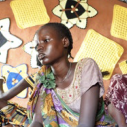
Search
Uzbekistan’s Multidimensional Approach to Poverty: An Interview with Obid Khakimov

On 28 May 2024, Obid Khakimov, Director of the Center for Economic Research and Reforms (CERR) under the Administration of the President of the Republic of Uzbekistan, presented an overview of ‘Poverty Reduction Policies in Uzbekistan’ at a roundtable discussion of policy efforts to reduce monetary and multidimensional poverty in Uzbekistan. The roundtable, which was hosted by the Embassy of Uzbekistan to the United Kingdom and OPHI, took place in the Oxford Department of International Development at the University of Oxford.
In February 2024, CERR launched a pilot Multidimensional Poverty Index (MPI) to measure poverty in the country. Uzbekistan is aiming to launch a national MPI as an official measure in due course. Building on this momentum, CERR hosted the 9th MPPN Annual Meeting in Tashkent from 27-29 August 2024. In this interview Khakimov discussed Uzbekistan’s work on multidimensional poverty.
What is the recent history of poverty in Uzbekistan and why did the country decide to measure multidimensional poverty?
In 2017 in Uzbekistan, we started very important reforms as we were a developing country at that time. Our per capita income was about $1,800 per capita.
In 2020, Uzbekistan started implementing a large anti-poverty programme. At that time, we didn’t have [any] kind of poverty measurements. So, the first step in this process was adopting monetary poverty measurement with the World Bank. And according to this measurement, we have reduced poverty during the last two years from 17% to 11%, which is a 6 percentage points decline in the monetary poverty rate.
But the poverty rate is not a single dimension problem. [Poverty] has lots of different dimensions. The President’s policy is targeting different directions [of poverty] using different policy instruments covering, for example, education, the health care system, the environment, entrepreneurship etc. When you fight with poverty, you have to go from the different angles with different policies.
When you are developing this kind of multidimensional policy, you must have multidimensional indicators which give you information about the efficiency of your policies. So that’s why in Uzbekistan, at the CERR, we started piloting this MPI. When we started the piloting, first we asked people when they considered themselves as poor. Based on these preferences, we generated a new index, which is the MPI specifically for Uzbekistan. That’s why this measure is the compass of our policy against poverty.
“I think that even developed countries should have [a national MPI], which can guide government policies in different directions efficiently.”
Can you tell us about Uzbekistan’s pilot MPI and the next steps for making this an official measure of poverty for Uzbekistan?
After finishing this pilot, the government has adopted this policy already. We included these [Multidimensional Poverty Index] questionnaires into the Household Budget Survey, which is conducted by the state statistics agency. Every year Uzbekistan’s state statistics agency conducts a Household Budget Survey, which is huge: 16,000 households. In the forthcoming months, we will get the first measurement of the MPI, which will give us the state of our multidimensional poverty.
In the following years, we will measure in which dimensions we are making more progress, and in which dimensions we must do more significant work. So that’s why this will be very important information in the policymaking process.
If you looked at the former Soviet Union republics, Uzbekistan is one of few countries which have this kind of instrument. So that’s [also] why it is very important.
What advice would you give to other countries embarking on introducing MPIs?
I think that not only developing countries should have MPIs. I think that even developed countries should have this kind of measure, which can guide government policies in different directions efficiently. It’s not only about deprivation. It’s also about improvement in different directions… because [otherwise] the governments might be wasting resources in some directions where they’re not very effective.
This article was published in Dimensions 17















